Inside The New York Botanical Garden
Uncategorized
Posted in Uncategorized on July 1 2009, by Plant Talk
 Carol Capobianco is Editorial Content Manager at The New York Botanical Garden.
Carol Capobianco is Editorial Content Manager at The New York Botanical Garden.
 We can hardly believe it, but a year has already passed since our blog content team first assembled and officially launched Plant Talk: Inside The New York Botanical Garden.
We can hardly believe it, but a year has already passed since our blog content team first assembled and officially launched Plant Talk: Inside The New York Botanical Garden.
Since then we’ve brought you a full schedule of posts from Monday through Friday on a broad range of topics, from gardening tips and science stories to behind-the-scenes glimpses and fun things to see and do. And we’ve had an extensive field of interesting contributors—at last count, over 70 people had written entries, including staff members from a variety of departments, students, and volunteers.
Along the way we’ve picked up a number of fans: people who have selected Plant Talk as one of their favorite blogs or who have added us to their blog rolls or who have written about us on their own Web pages.
We hope you are enjoying the ride as much as we are. Please let us know what you’ve liked and what you’d like to see more of. As always, we look forward to hearing from you as we continue to share with you all the wonderful exhibitions, garden collections, programs, research, classes, and more taking place here at The New York Botanical Garden.
Posted in Uncategorized on June 30 2009, by Plant Talk
 |
Sandra Herbst is Public Relations Assistant. |
Let me start by saying I was never a nature person. I went camping when I was younger, but to some people, having air conditioning and a TV in your camper doesn’t count.
My appreciation of nature first began when I started taking my lunchtime walks around the Garden grounds last spring. I started walking as a way to get back into shape—we all want to fit into our teeny-weeny yellow polka-dot bikini, right?
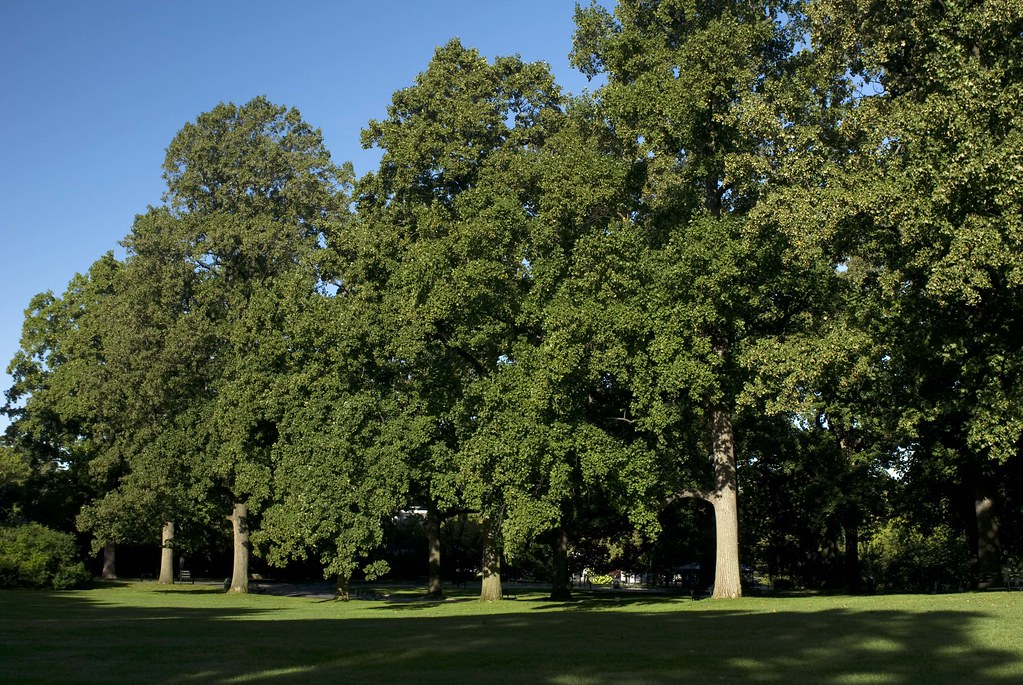 My route begins at the Watson Education Building, goes up Magnolia Way and past the Peggy Rockefeller Rose Garden, then down Azalea Way to the Everett Children’s Adventure Garden where I reverse course to return to the Watson Building. For me it takes about 45 minutes; for some of the joggers from Fordham University I see frequently, I’m sure less. These walks have become significant to me. They have become my peace, my happiness, and my way to de-stress during the 9-to-5 work week.
My route begins at the Watson Education Building, goes up Magnolia Way and past the Peggy Rockefeller Rose Garden, then down Azalea Way to the Everett Children’s Adventure Garden where I reverse course to return to the Watson Building. For me it takes about 45 minutes; for some of the joggers from Fordham University I see frequently, I’m sure less. These walks have become significant to me. They have become my peace, my happiness, and my way to de-stress during the 9-to-5 work week.
These walks have also made me love and appreciate the Garden for all of its natural beauty and structure. Seeing the cherry trees bloom in spring; the lush colors of green during the summer; and the rich reds, pinks, and oranges of the Rose Garden in the early fall always makes me smile. My eyes can never turn away from the green tree line against the bright, blue sky. This spring, I even started to count the number of bird nests I saw. There were so many, and of course, I came up with a different number each time.
 I can remember seeing Boyfriend and Girlfriend for the first time this year. Boyfriend and Girlfriend are the names I gave two ducks, one male, one female, that I saw all the time during my walks last year. They were always together in the tiny stream on Azalea Way near the Forest entrance. I saw them for the first time this spring in the Reflecting Pool while walking with a co-worker, and I blurted out “There’s Boyfriend and Girlfriend!” Of course, she had no idea what I was talking about, but I knew, and I was so excited to see them together again.
I can remember seeing Boyfriend and Girlfriend for the first time this year. Boyfriend and Girlfriend are the names I gave two ducks, one male, one female, that I saw all the time during my walks last year. They were always together in the tiny stream on Azalea Way near the Forest entrance. I saw them for the first time this spring in the Reflecting Pool while walking with a co-worker, and I blurted out “There’s Boyfriend and Girlfriend!” Of course, she had no idea what I was talking about, but I knew, and I was so excited to see them together again.
I still wouldn’t call myself a full-blown nature lover or anything. But I sure have come to appreciate the comfort, beauty, and serenity the Garden and nature offers.
Posted in Uncategorized on June 19 2009, by Plant Talk
…and a Farewell to Spring
 |
Jessica Blohm is Interpretive Specialist for Public Education. |
Tomorrow marks the longest day of the year, the day when the sun is farthest north in the sky and we have the greatest number of daylight hours. Also known as the Summer Solstice, this day marks the end of spring and the beginning of summer. We are eager for warmer and drier days, but before we turn the page, let’s reflect on what an amazing spring it has been here at the Garden.
From exhibitions such as The Glory of Dutch Bulbs: A Legacy of 400 Years to the magnificent spectacle of flowering trees and perennials across the grounds, spring has been truly unique. And none of these extensive, glorious displays and exhibitions would be possible without the dedication of the Arboretum and Grounds crew and Outdoor Gardens staff.
So we say thank you to all for their good work, whether it be planting, trimming, placing sod, arranging planters, or transferring soil. Here we show you some behind-the-scenes images of what helped make the spring displays so remarkable.
Check out all of Saturday’s programming
Check out all of Sunday’s programming
Posted in Uncategorized on June 10 2009, by Plant Talk
 Gregory Long is President and CEO of The New York Botanical Garden.
Gregory Long is President and CEO of The New York Botanical Garden.
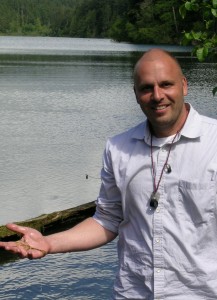 A couple of weeks ago, I had a quintessential New York Botanical Garden day, and I want you to hear about it, as it tells a wonderful story about the people, programs, and collections of this remarkable place.
A couple of weeks ago, I had a quintessential New York Botanical Garden day, and I want you to hear about it, as it tells a wonderful story about the people, programs, and collections of this remarkable place.
It began in the conference room of our Plant Research Laboratory with a scientist new to the Garden, Ken Karol (right), presenting a short lecture on our current research into the Tree of Life—the evolution of plants from green algae up to flowering plants. As you may know, here at the Botanical Garden we are substantially revising scientific thought about evolution because of the research and work conducted in our Cullman Program for Molecular Systematics.
 Later that morning I spent some time in our beautiful Howell Family Garden watching a few volunteers and two groups of Bronx second-graders—children maybe 7 or 8 years old—planting lettuce seedlings in fertile, black composty beds that the kids had learned how to prepare. Afterward I saw those same kids marching behind their teachers to go over to tour the Haupt Conservatory to see the plants of the world and a spectacular flower show.
Later that morning I spent some time in our beautiful Howell Family Garden watching a few volunteers and two groups of Bronx second-graders—children maybe 7 or 8 years old—planting lettuce seedlings in fertile, black composty beds that the kids had learned how to prepare. Afterward I saw those same kids marching behind their teachers to go over to tour the Haupt Conservatory to see the plants of the world and a spectacular flower show.
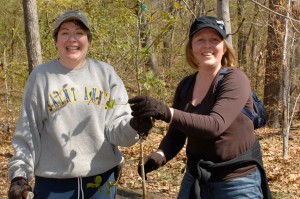 Then my friend (and Board Member) Tom Hubbard came for a visit, and we went with our Forest Manager, Jessica Arcate, into the Garden’s first-growth Forest to visit a site where many very fit volunteers, including Florence Davis of The Starr Foundation (near right with Joanna Baginski) and Board Member Julie Sakellariadis, were planting hundreds of trees to reforest the Forest. It was an inspiring scene.
Then my friend (and Board Member) Tom Hubbard came for a visit, and we went with our Forest Manager, Jessica Arcate, into the Garden’s first-growth Forest to visit a site where many very fit volunteers, including Florence Davis of The Starr Foundation (near right with Joanna Baginski) and Board Member Julie Sakellariadis, were planting hundreds of trees to reforest the Forest. It was an inspiring scene.
 To top it all off, later in the day I was in the Mertz Library, where I met two of our new graduate students and saw a research librarian with a class of our Botanical Art students in the Rare Book Room studying sumptuous 18th-century illustrated plant books.
To top it all off, later in the day I was in the Mertz Library, where I met two of our new graduate students and saw a research librarian with a class of our Botanical Art students in the Rare Book Room studying sumptuous 18th-century illustrated plant books.
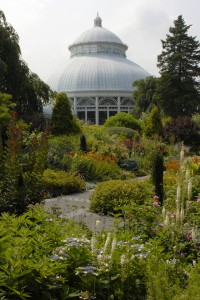 These vignettes are snapshots of the life of the Garden—what’s amazing here is the combination of art and nature, fun and learning, science and conservation, and high intellectual endeavor set in this beautifully planted and maintained sanctuary that we share with millions of people—from graduate students to 7-year-olds.
These vignettes are snapshots of the life of the Garden—what’s amazing here is the combination of art and nature, fun and learning, science and conservation, and high intellectual endeavor set in this beautifully planted and maintained sanctuary that we share with millions of people—from graduate students to 7-year-olds.
Many generations of scientists, horticulturists, educators, administrators, architects, garden designers, and Board Members have labored in a long and sustained effort—since the 1890s—to design and improve; to plant, write, teach; and to make the Garden beautiful and significant. We are privileged to be the contemporary generation fitting into this long continuum.
Posted in Uncategorized on May 19 2009, by Plant Talk
“Greening” Existing Buildings Works Toward Mayor’s Proposal
 |
Daniel Avery is Sustainability and Climate Change Program Manager at The New York Botanical Garden. |
On Earth Day last month, City Council Speaker Christine Quinn and Mayor Mike Bloomberg announced major new legislative proposals to increase energy efficiency in existing buildings. The measures, some of which will no doubt prove controversial (and, perhaps in some cases, difficult politically to get through), are a response to the reality of reducing emissions in a densely urban setting.
As perhaps you noticed the last time you strolled around your city block (or any city block), there are buildings everywhere, and collectively they contribute the vast majority—about 80 percent—of New York City’s greenhouse gases. In addition, of the buildings that will be standing in 2030, the date by which the Mayor’s PlaNYC 2030 envisions a 30 percent reduction in greenhouse gases from 2005 levels, 90 percent have already been built. This is why Rohit Aggarwala, Director of the Mayor’s Office of Long-Term Planning and Sustainability, said to The New York Times regarding the proposed legislation: “Existing buildings are in fact the nut that must be cracked if we are ever going to make a dent on the demand side in terms of energy.”
In terms of buildings, The New York Botanical Garden is much like the city: We have a lot of buildings of many different ages performing an astonishing number of different tasks. We represent, in short, a microcosm of the City’s challenge to reduce building-related emissions. And over the years we have been quietly going at this problem. Such efforts are not as visible or as easy to explain as new green buildings (if you find the list below exciting, you’re officially a policy nerd), but in many ways they are more challenging and more important.
Read More
Posted in Uncategorized on May 13 2009, by Plant Talk
Bronx Officials Open Children’s Nutrition and Urban Farming Programs
 |
Nick Leshi is Associate Director of Public Relations and Electronic Media. |
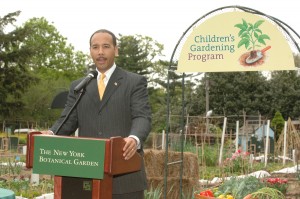
New Bronx Borough President Ruben Diaz Jr. spoke last week at The New York Botanical Garden’s Ruth Rea Howell Family Garden to officially open the vegetable gardening season. He recognized the Botanical Garden’s role in educating kids and the public about the importance of nutrition and healthy eating in combating obesity and other health issues and how community gardens help generate “green-collar” jobs in the city. Vegetable gardening and healthy eating will be showcased in The Edible Garden, a summer-long celebration of growing great food, June 27–September 13, at the Botanical Garden.
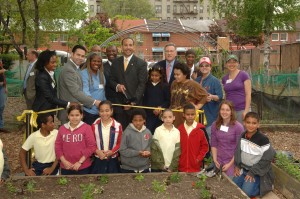
One of Bronx Green-Up’s community gardens, the Garden of Happiness on Prospect Avenue between East 181st and 182nd Streets in the Bronx, was abuzz with activity for the start of the gardening season. Among those on hand were, from left to right, Judge Dianne T. Renwick, City Councilman Joel Rivera, Community Gardener Karen Washington, City Councilman Larry B. Seabrook, Bronx Borough President Ruben Diaz Jr., New York Botanical Garden President Gregory Long, Bronx school children, and NYBG’s Director of Bronx Green-Up & Community Horticulture Ursula Chance (far right in purple shirt).
Photos by Jason Green
Posted in Uncategorized on April 15 2009, by Plant Talk
How? With a Gift Annuity to the Garden
 Paul Parvis is Manager of Planned Giving.
Paul Parvis is Manager of Planned Giving.
Taxes need not be so— taxing.
The key is to plan ahead. My wife and I managed another year of preparing our tax returns, and we did so by revisiting our financial strategies soon after completing our taxes at this time last year. We kept thinking of five criteria: earnings, tax withholdings, deferred retirement savings amount, charitable giving, and lastly, what we owed! Increasing our retirement savings and charitable giving last year significantly reduced the tax amount due this year.
Enter the gift annuity—the gift that gives twice.
With a gift annuity, you irrevocably transfer cash or stock in exchange for an immediate tax deduction and guaranteed annual payments for life. For a cash transfer of $10,000, for example, a 65-year-old person would receive $530 per year of which $351 would be exempt from personal income tax for an effective rate of 7.3 percent.
To learn more about gift annuities…
Read More
Posted in Uncategorized on December 30 2008, by Plant Talk
Posted in Uncategorized on December 23 2008, by Plant Talk
 Carol Capobianco is Editorial Content Manager at The New York Botanical Garden.
Carol Capobianco is Editorial Content Manager at The New York Botanical Garden. We can hardly believe it, but a year has already passed since our blog content team first assembled and officially launched Plant Talk: Inside The New York Botanical Garden.
We can hardly believe it, but a year has already passed since our blog content team first assembled and officially launched Plant Talk: Inside The New York Botanical Garden.















